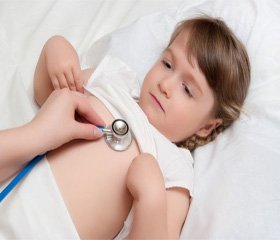Журнал «Здоровье ребенка» 1 (52) 2014
Вернуться к номеру
Genetic polymorphism of secretoglobin SCGB1A1 and the development of lung disease in children
Авторы: Malaya N.K., Kaladze N.N., Maly K.D.
Рубрики: Педиатрия/Неонатология
Разделы: Справочник специалиста
Версия для печати
Bronchial asthma (BA) is still one of the global public health problem, especially in connection with it widely spread (in some countries are affected 1–18 % of the population) and increasing the incidence in recent years. The problem is particulary acute for pediatrics because of heavier course of disease and more seriously complications in children. This problem is also very actual for Ukraine because the incidence of BA in children achieves 15 %.
The syndrome of BA, as a typical multifactorial disease, depends on the combined effects of many factors, including those which affect the respiratory tract mucosa. One such factor is the product of Clara cells – secretoglobin SCGB1A1 (uteroglobin CC16). SCGB1A1 is protein with low molecular weight, which has many properties, including immunomodulatory and antiinflumatory. The gen of SCGB1A1 is located on 11 chromosome, and its length is 4172 nucleotides. It is defined some types of the genetic polymorphism for SCGB1A1, one of them – A(38)G-polymorphism is associated with increased risk of developing BA. The genetic polymorphism can vary in different ethnic and geographical population, so the purpose of our investigation was to determine the level of A(38)G genetic polymorphism SCGB1A1 in Crimea children, to identify the correlation between it and developing of BA.
It were investigated DNA samples from children with BA, children with recurrent bronchitis without obstruction (RB) and healthy children (not suffering from pulmonary pathology). It was observed 114 children from 6 to 16 years old. Group of patients with BA was 75 children. 68% from them were boys (51 patients) and 32 % were girls (24 patients). 63 % from them (47 children) were in remission and 37% (28 children) in exacerbation. 38 patients (51 %) were diagnosed with intermittent asthma, 26 patients (34,5 %) – mild persistent asthma, 11 patients (14,5 %) with moderate persistent asthma. Group of patients with RB was consisted of 19 children and group of healthy was consisted of 20 children.
The DNA samples were distinguished from surveyed peripheral blood and saliva by phenol-chloroform extraction. A(38)-polymorphism was determined by PCR with method of allele discrimination, using a system of 3 primers. PCR was conducted in volume 25 mkl in two tubes, in first of them were a forward primer 1 and reverse primer, in second tube were a forward primer 2 and reverse primer. After amplifications and electrophoresis in 3% agarose gel in presence of ethidium bromide the results of amplifications were detected in the ultraviolet light. And then were calculated the frequencies of alleles and their combinations, and their conformity with Hardy-Weinberg equilibrium by χ2, rejecting the null hypotheses at Р < 0,05.
Analyzing the results of our investigation can be seen that the frequency of allele A (A or G) between the studied groups were not significantly different. Allele A is observed in 31–36 % and allele G is observed in 64–69 % of all cases.
In the groups of patients with BA and control group the frequency of allelic variants are not statistically different from its expected value, so the Hardy-Weinberg equilibrium within these groups is not broken. But in group of RB there are found significant statistically differences between the observed and the expected frequencies of occurrence all allelic variants, in particular the frequency of homozygous allele combinations AA and GG are dramatically increased and heterozygous allele combination AG is extremely rare. Almost 90 % patients in comparing with 46 % expected in this group exhibit a homozygous condition.
Significant differences between groups are observed in comparing the frequencies of allele’s combinations – homozygotes AA and GG and heterozygotes AG. It is observed that homozygotes with allele combination AA are founded significantly often in patients with RB (32 %) in comparing with patients suffering from BA (5 %). Also in patients with RB it is observed that homozygotes with allele combination GG are founded significantly often then in other groups (58 %). In group with BA the heterozygous allele combination AG is observed significantly higher (52 %) then in group with RB (10 %). In the control group of healthy children the results are intermediate between group patients with BA and RB.
Conclusions:
1. It is registered the A(38)G-polymorphism of secretoglobin SCGB1A1 in Crimea children.
2. The frequency of allele combinations is different in patients with bronchial asthma, recurrent nonobstructive bronchitis and in control group. The frequency of homozygous allele combination AA is lower in group patients with BA and is higher in group with RB, then in control group. The frequency of heterozygous allele combination AG is higher in group patients with BA then in patients with RB and control group.
3. The frequency of heterozygotes AG in patients with RB is lower than the frequency of homozygotes AA and GG.

